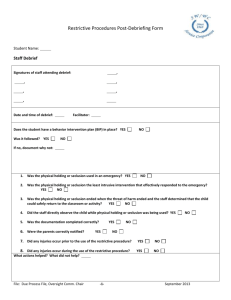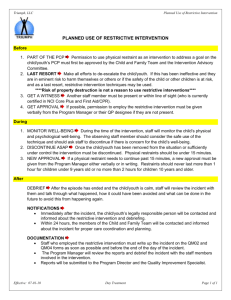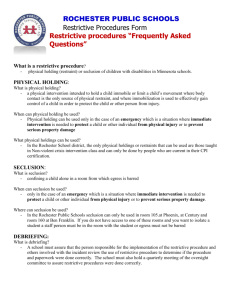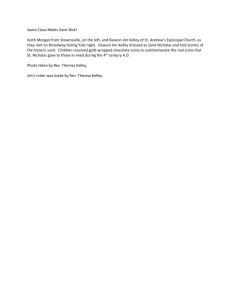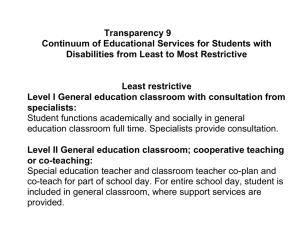Restrictive Procedures Plan William Kelley
advertisement
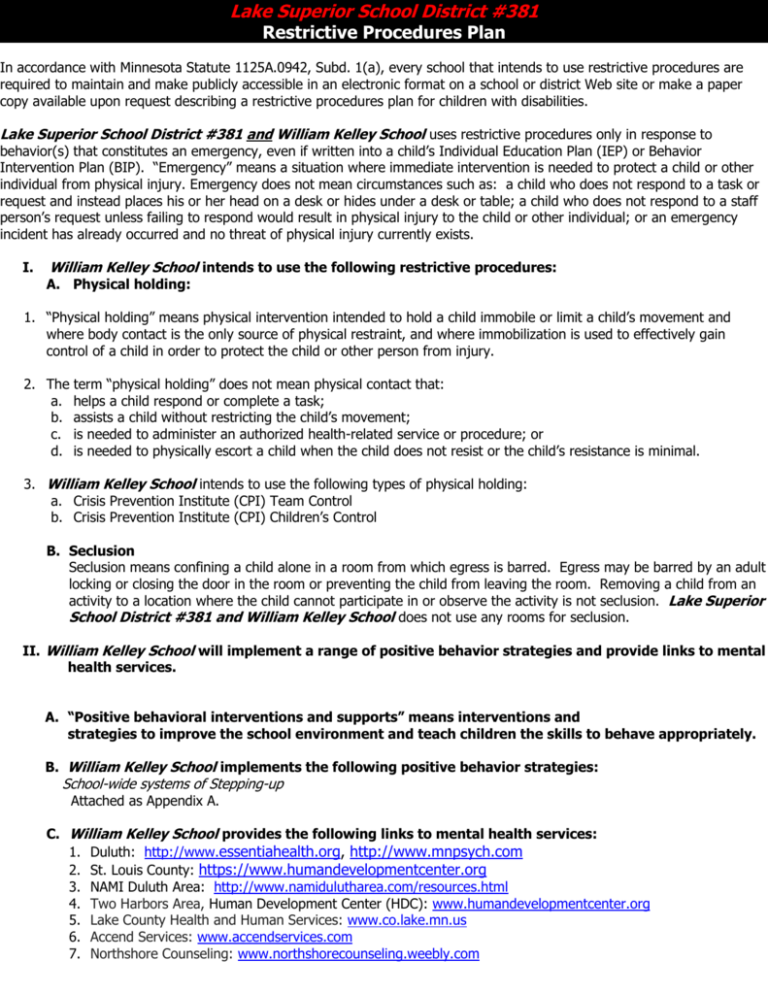
Lake Superior School District #381 Restrictive Procedures Plan In accordance with Minnesota Statute 1125A.0942, Subd. 1(a), every school that intends to use restrictive procedures are required to maintain and make publicly accessible in an electronic format on a school or district Web site or make a paper copy available upon request describing a restrictive procedures plan for children with disabilities. Lake Superior School District #381 and William Kelley School uses restrictive procedures only in response to behavior(s) that constitutes an emergency, even if written into a child’s Individual Education Plan (IEP) or Behavior Intervention Plan (BIP). “Emergency” means a situation where immediate intervention is needed to protect a child or other individual from physical injury. Emergency does not mean circumstances such as: a child who does not respond to a task or request and instead places his or her head on a desk or hides under a desk or table; a child who does not respond to a staff person’s request unless failing to respond would result in physical injury to the child or other individual; or an emergency incident has already occurred and no threat of physical injury currently exists. I. William Kelley School intends to use the following restrictive procedures: A. Physical holding: 1. “Physical holding” means physical intervention intended to hold a child immobile or limit a child’s movement and where body contact is the only source of physical restraint, and where immobilization is used to effectively gain control of a child in order to protect the child or other person from injury. 2. The term “physical holding” does not mean physical contact that: a. helps a child respond or complete a task; b. assists a child without restricting the child’s movement; c. is needed to administer an authorized health-related service or procedure; or d. is needed to physically escort a child when the child does not resist or the child’s resistance is minimal. 3. William Kelley School intends to use the following types of physical holding: a. Crisis Prevention Institute (CPI) Team Control b. Crisis Prevention Institute (CPI) Children’s Control B. Seclusion Seclusion means confining a child alone in a room from which egress is barred. Egress may be barred by an adult locking or closing the door in the room or preventing the child from leaving the room. Removing a child from an activity to a location where the child cannot participate in or observe the activity is not seclusion. Lake Superior School District #381 and William Kelley School does not use any rooms for seclusion. II. William Kelley School will implement a range of positive behavior strategies and provide links to mental health services. A. “Positive behavioral interventions and supports” means interventions and strategies to improve the school environment and teach children the skills to behave appropriately. B. William Kelley School implements the following positive behavior strategies: School-wide systems of Stepping-up Attached as Appendix A. C. William Kelley School provides the following links to mental health services: 1. Duluth: http://www.essentiahealth.org, http://www.mnpsych.com 2. St. Louis County: https://www.humandevelopmentcenter.org 3. NAMI Duluth Area: http://www.namidulutharea.com/resources.html 4. Two Harbors Area, Human Development Center (HDC): www.humandevelopmentcenter.org 5. Lake County Health and Human Services: www.co.lake.mn.us 6. Accend Services: www.accendservices.com 7. Northshore Counseling: www.northshorecounseling.weebly.com William Kelley School will monitor and review the use of restrictive procedures III. in the following manner: A. Documentation 1. Each time physical holding is used, the staff person who implements or oversees the physical holding shall document, as soon as possible after the incident concludes, the following information: A description of the incident that led to the physical holding; Why a least restrictive intervention failed or was determined by staff to be inappropriate or impractical; The time the physical holding began and the time the child was released; and A brief record of the child’s behavioral and physical status. 2. Attached as Appendix B, is William Kelley School‘s forms used to document the use of physical holding. B. Post-use debriefings, consistent with documentation requirements: 1. Each time physical holding is used, the staff person who implemented or oversaw the physical holding shall conduct a post-use debriefing with case manager and building principal, within 2 school days after the incident concludes. 2. The post-use debriefing will review the following requirements to ensure the physical holding or seclusion was used appropriately: Whether the physical holding was used in an emergency; Whether the physical holding was the least intrusive intervention that effectively responds to the emergency; Whether the physical holding was used to discipline a noncompliant child; Whether the physical holding ended when the threat of harm ended and the staff determined that the child could safely return to the classroom or activity; Whether the staff directly observed the child while physical holding was being used; Whether the documentation was completed correctly; Whether the parents were properly notified; Whether an IEP team meeting needs to be scheduled; Whether the appropriate staff used physical holding or seclusion; Whether the staff that used physical holding was appropriately trained. 3. If the team determines, through the post-use debriefing, the use of physical hold or seclusion was not used appropriately, William Kelley School will ensure immediate corrective action is taken, such as administrative review of procedures and staff training. C. Oversight Committee 1. William Kelley School publicly identifies the following oversight committee members Jean Brandt, school psychologist Ryan Stengl, school counselor Lela Goettl, EBD teacher Mr. J. Nicklay, Building Principal Cathy Tryggestad, Special Education Director 2. William Kelley School oversight committee meets quarterly. 3. William Kelley School oversight committee will review the following: The use of restrictive procedures based on patterns or problems indicated by similarities in the time of day, day of week, duration of the use of a restrictive procedure, the individuals involved, or other factors associated with the use of a restrictive procedures; The number of times a restrictive procedure is used school wide and for individual children; The number and types of injuries, if any, resulting from the use of restrictive procedures; Whether restrictive procedures are used in nonemergency situations; The need for additional staff training; and Proposed actions to minimize the use of restrictive procedures. William Kelley School staff who use restrictive procedures, including paraprofessionals, received training in IV. the following skills and knowledge areas: A. Positive behavioral interventions: CPI Crisis Development Model, Verbal Interventions B. Communicative intent of behaviors: CPI Unit entitled: CPI Crisis Development Model, Preventative Techniques C. Relationship building: CPI Unit entitled: Preventative Techniques D. Alternative to restrictive procedures, including techniques to identify events and environmental factors that may escalate behavior: CPI Unit entitled: Precipitated Factors, Rational Detachment, Integrated Experience E. De-Escalation methods: CPI Unit entitled: CPI Crisis Development Model F. Standards for using restrictive procedures only in an emergency: CPI Unit entitled: Nonviolent Physical Crisis and Team Intervention, & Understanding the Risks of Restraints G. Obtaining emergency medical assistance: Nonviolent Physical Crisis Intervention and Team intervention, & training on local numbers to call in case of an emergency H. The physiological impact of physical holding and seclusion: CPI Unit entitled: Nonviolent Physical Crisis and Team Intervention, Understand the Risks of Restraints, & Crisis Development Model I. Monitoring and responding to a child’s physical signs of distress when physical holding is being used: CPI Unite entitled: Nonviolent Physical Crisis Intervention and Team Intervention J. Recognizing the symptoms of and interventions that may cause positional asphyxia when physical holding is used: CPI Unit entitled: Participant workbook Chapter Understanding the Risks of Restraints K. District policies and procedures for timely reporting and documenting each incident involving use of a restrictive procedure; and L. Schoolwide programs on positive behavior strategies The district will maintain records of staff that have been training and the organization or professional that conducted the training. M. Accommodating, modifying and adapting curricula, materials, and strategies to appropriately meet the needs of individual student and ensure adequate progress: Knowledge in accommodating, modifying, and adapting curricula materials and strategies to appropriately meet the needs of individual students and ensure adequate progress towards the state’s graduation standards. V. William Kelley School will never use the following prohibited procedures on a child: A. Engaging in conduct prohibited under section 121 A.58 (corporal punishment); B. Requiring a child to assume and maintain a specified physical position, activity that induces physical pain; C. Totally or partially restricting a child’s senses as punishment; D. Presenting an intense sound, light, or other sensory stimuli using spray as punishment; E. smell, taste, substance, or Denying or restricting a child’s access to equipment and devices such as walkers, wheelchairs, hearing aids, and communication boards that facilitate the child’s functioning, except when temporarily removing the equipment or device is needed to prevent injury to the child or others or serious damage to the equipment or device, in which case the equipment or device shall be returned to the child as soon as possible; F. Interacting with a child in a manner that constitutes sexual abuse, neglect, or physical abuse under section 626.556 (reporting of maltreatment of minors); G. Withholding regularly scheduled meals or water; H. Denying access to bathroom facilities; and I. Physical holding that restricts or impairs a child’s ability to breathe, restricts or impairs a child’s ability to communicate distress, places pressure or weight on a child’s head, throat, neck, chest, lungs, sternum, diaphragm, back, or abdomen, or results in straddling a child’s torso. Date of plan: NOV 2015 Revised: NOV 2015 CT/2014
